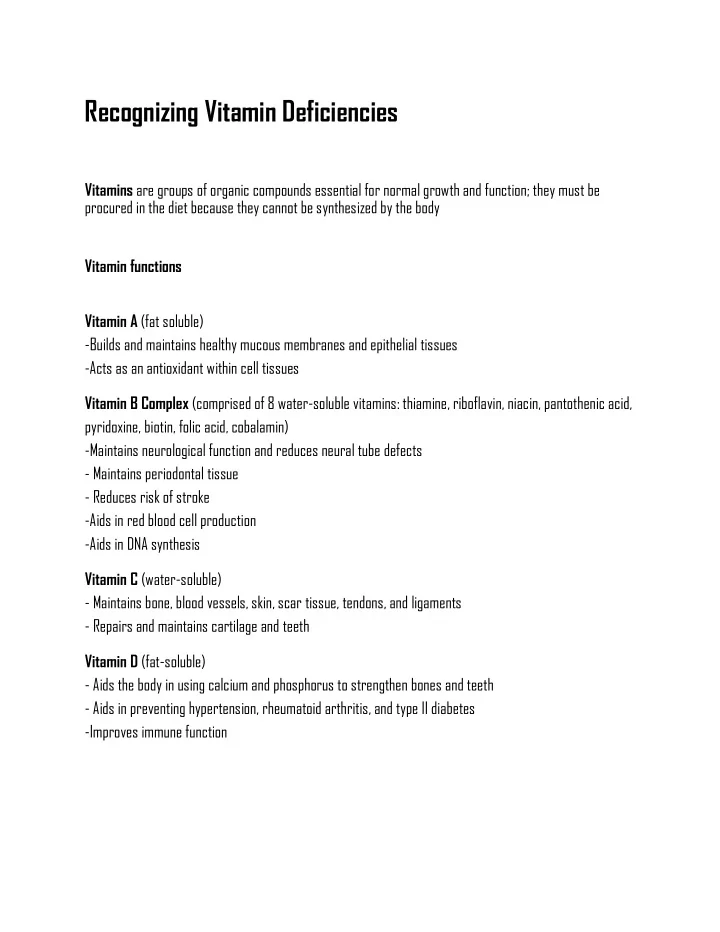

Recognizing Vitamin Deficiencies Vitamins are groups of organic compounds essential for normal growth and function; they must be procured in the diet because they cannot be synthesized by the body Vitamin functions Vitamin A (fat soluble) -Builds and maintains healthy mucous membranes and epithelial tissues -Acts as an antioxidant within cell tissues Vitamin B Complex (comprised of 8 water-soluble vitamins: thiamine, riboflavin, niacin, pantothenic acid, pyridoxine, biotin, folic acid, cobalamin) -Maintains neurological function and reduces neural tube defects - Maintains periodontal tissue - Reduces risk of stroke -Aids in red blood cell production -Aids in DNA synthesis Vitamin C (water-soluble) - Maintains bone, blood vessels, skin, scar tissue, tendons, and ligaments - Repairs and maintains cartilage and teeth Vitamin D (fat-soluble) - Aids the body in using calcium and phosphorus to strengthen bones and teeth - Aids in preventing hypertension, rheumatoid arthritis, and type II diabetes -Improves immune function
Oral Clinical Signs of Vitamin Deficiencies Vitamin A -Gingival inflammation - Oral candidiasis (yeast infection) Vit. A deficiency- Oral Candidiasis - Impaired taste Vitamin B Complex - B2 (riboflavin): shiny red lips, sore tongue, cracked lips, angular cheilitis, glossitis, hyperemia and edema of oral and pharyngeal mucosa - B3 (niacin): red/swollen apex of tongue with Vit. B12 deficiency- Xerostomia smooth dry edges, angular cheilitis, mouth pain - B6 (pyridoxine): sore burning mouth, angular cheilitis, smooth tongue - B12 (cobalamin): halitosis, angular cheilitis, bright red tongue with//without fissures, xerostomia, numb and bleeding gums Vit. C deficiency- Scurvy Vitamin C - Gingival inflammation with smooth appearance -Bluish-red gingiva -Soft, friable gingiva -Scurvy (bleeding gums, loose teeth, petechial hemorrhage of skin and mucous membranes) *Calculus acts as an irritant Vit. B2 deficiency- Glossitis and Angular Cheilitis Vitamin D -Softens bones and teeth by decreasing density
Dietary Sources of Vitamins Vitamin A -Beef liver, broccoli, red-orange fruits and vegetables (squash, carrots, apricots, cantaloupe, peaches, papaya, red peppers), dairy products, fortified breakfast cereals Vitamin B Complex - Green leafy vegetables (esp. spinach), soy beans, almonds, walnuts, sunflower and sesame seeds, sprouts, fish, beef liver, fortified breakfast cereals Vitamin C - Citrus fruits, broccoli, cauliflower, cabbage, and brussel sprouts Vitamin D - Fish, fortified dairy products and juices, and eggs *Synthesized in body by sunlight
Role of the Dental Hygienist - Utilize the health history interview to establish what vitamin supplements the patient may be taking - Have the ability to recognize clinical signs of vitamin deficiencies in the oral cavity - Explain how vitamin deficiencies modify the body’s response to dental biofilm and contribute to gingival disease - Provide patient with diet and nutritional counseling - During counseling, food-based approaches to diversify diet and increase nutrient intake should be prioritized over vitamin supplementation - Refer the patient for medical consultation if a serious deficiency is suspected, there may be underlying systemic factors associated
Recommend
More recommend